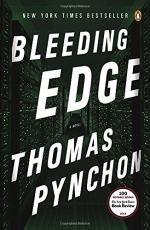|
This section contains 367 words (approx. 1 page at 400 words per page) |

|
Point of View
Thomas Pynchon tells his novel “Bleeding Edge” in the third-person limited-omniscient point of view with Pynchon serving as the narrative voice. This is done for at least three reasons. The first is that Pynchon is able to tell the story of Maxine and her investigation into hashslingrz and 9/11. The second is that Pynchon takes sections of the novel aside from the actual story to provide contextual information, to address the reader directly, or to include personal considerations or observations of events. For example, in Chapter 30, Pynchon directly addresses the reader while also providing contextual information about the reaction to the events of September 11. This creates a sense of depth as Pynchon breaks the fourth wall and provides important and relevant information to what is going on. Third, the limited-omniscient aspect of the novel allows the reader to learn about things only as Maxine learns about...
|
This section contains 367 words (approx. 1 page at 400 words per page) |

|




